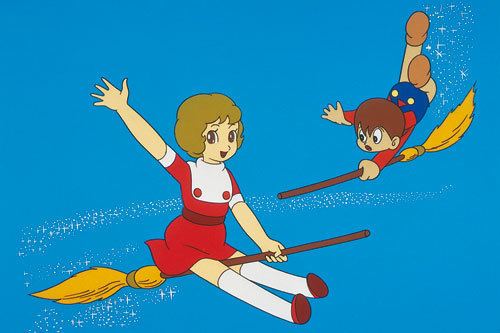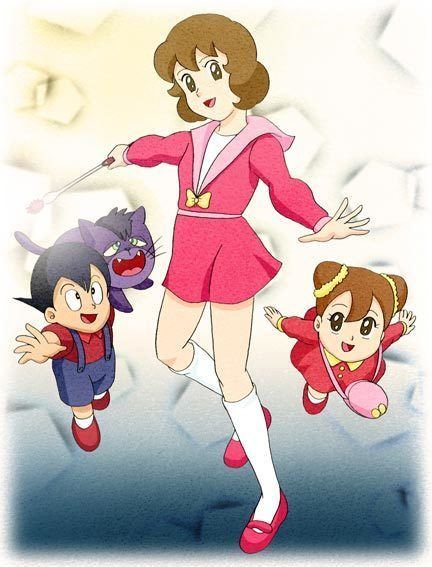Publisher Shueisha | Original run July 1966 – 1967 | |
 | ||
Similar Akakage, Ōgon Bat, 8 Man, Senbei Norimaki, Moonlight Mask | ||
Sally mal arodejnice mahoutsukai sally
Sally the Witch (魔法使いサリー, Mahōtsukai Sarī) also known as Sunny the Witch is one of the popular anime magical girls of what eventually become a genre in Japan. Due to its characteristics, may be considered the first anime shōjo as well.
Contents
- Sally mal arodejnice mahoutsukai sally
- angerme sally the witch promotion edit
- Story
- Characters
- Release
- History and legacy
- Other media
- In popular culture
- References

The 1989 season of Sally the Witch is a popular new update of the original version and made it Sally the Witch 2 which is like Himitsu no Akko-Chan 2 and Sailor Moon but developed in TV Asahi.

The theme song has a genre of Dixieland (or in the 1989 is 80's electro or the 2000s is J-Pop).

angerme sally the witch promotion edit
Story
Sally is the witch princess of the Magic Kingdom who longs to visit the mortal realm — presumably to make friends of her own age. One day, by mistake Sally teleports to the "mid world" (Earth), where she uses her magic to fend off a couple of burglars menacing two schoolgirls. Immediately befriended by her new acquaintances — tomboyish Yoshiko Hanamura (known affectionately as "Yotchan") and girly Sumire Kasugano — Sally decides to stay on indefinitely, leading to mischief. As with Samantha Stevens in Bewitched, Sally tries to keep her supernatural abilities secret, assuming the role of a human child.
In the final episode, Sally's grandma informs her she must return to the Magic Kingdom. Before leaving, Sally tries to tell her friends about her origins, but no one will believe her. Then her elementary school catches on fire, and Sally uses her magic to put it out. Her powers thus exposed, Sally's time to leave has finally come. She waves farewell to her friends, and returns to the Magic Kingdom.
Being so popular in Japan, mostly the same way as classic Hanna-Barbera characters are in America, a second series was produced 20 years later. The second series continues a few years after the original ending, and finishes with the Original video animation Sally the Witch: Mother's Love is Eternal, in which, at the end, Sally finally becomes the ruler Queen of the Magic Kingdom, but worries about leaving her friends behind.
Characters
Names are in Western order, with the family name after the given name.
Release
The first 17 episodes of the original 1960s TV series were filmed in black and white, and the remainder of the series was filmed in color, making it one of the earliest color anime. Black-and-white and color versions exist of the opening animation sequence.
A movie/TV special was made called Sally the Witch: Mother's Love is Eternal, which was the finale to the second series.
History and legacy
Sally the Witch was one of the first ongoing anime series produced. The series was originally in black and white but due to its success, later episodes were produced in color. The anime series was produced and aired from 1966 to 1968 in Japan by Toei Animation. Unlike Yokoyama's Tetsujin 28-go, the series never received a U.S. broadcast, but was aired in other several countries under different names. In Italy (Sally la Maga), French-speaking Canada (Minifée), Poland (Sally Czarodziejka — based on the Italian version), México and South America (Bolivia, Chile, Paraguay, and Peru) as La princesa Sally. Depending on the country, she's called Princess, Magician or Witch.
A second Sally the Witch anime, also made by Toei, aired for 88 episodes on Japanese TV from 1989 to 1991. It was released in French (Sally la Petite Sorcière), Italian (Un regno magico per Sally), Polish (Sally Czarownica), Spanish (Sally la Brujita) and Russian (Ведьма Салли). The 1989 series is a sequel to the original, in which an older Sally returns to the human world, reunites with her old friends, and embarks on a new round of magical adventures.
The main strength of Sally the Witch lays in its strong characterizations and detailed continuity. The basic storyline would be incorporated into many later magical girl TV anime shows and manga, particularly the concept of a magical princess relocating to the human world. Toei animation reutilized the same concept in Mahō Tsukai Chappy, 1972, and Majokko Megu-chan, 1974, but later become a recurrent basis for the magical girl theme, with later unrelated characters such as Sailor Moon, or even foreign productions such as Lolirock or Star vs. the Forces of Evil using the same base plot.
Other media
The first Sally manga series was drawn by Mitsuteru Yokoyama in 1966 and was, according to Yokoyama, inspired by the American sitcom, Bewitched (known in Japan as Oku-sama wa Majo, or The Miss is a Witch). The manga was used as basis for the original anime series.
Sally made an appearance as the character "Sunny the Magician" in the Giant Robo (OVA) series homaging and featuring characters and elements from many of Yokoyama's works.
In popular culture
Author Robert Jay Lifton stated that Sally Yumeno "has long been one of the most popular of all manga and animation characters." In December 1994 police found a pamphlet at the headquarters of Aum Shinrikyo which included a song called "Sarin the Magician," a parody of the theme song of Sally the Witch. Lifton said that Sally "was undoubtedly a prominent figure in the childhoods of leading Aum members."
In 2015, the Japanese idol girl group Angerme released a new updated upbeat dance version of the original anime opening from the first series.
